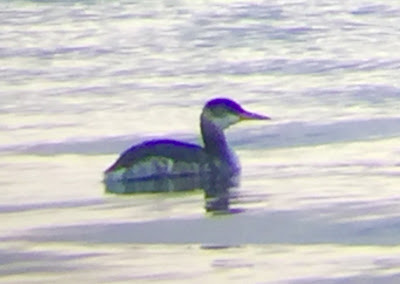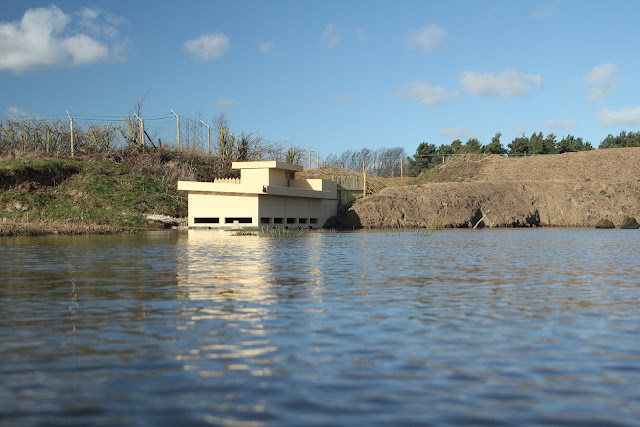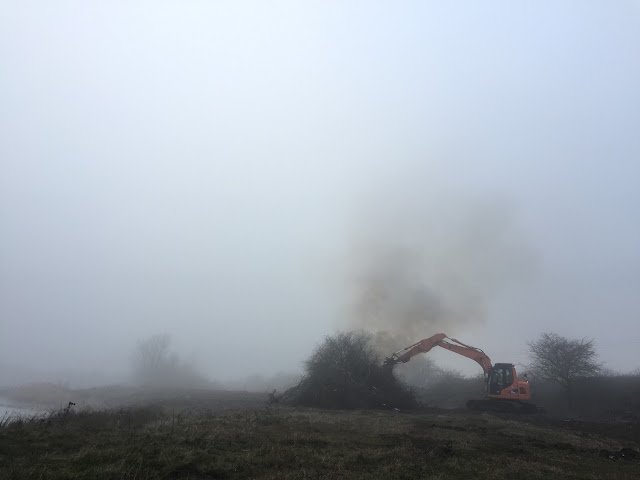A smattering of notable gulls has occurred with glaucous gulls - at least two juveniles with one bizarrely showing a similar daily cycle to last year's 'Billy'. Why Tophill has become such a popular winter destination for 1st winter glauc's is unknown - John Leason:
Caspian gulls too have occurred with some regularity and Mediterranean has been in typical numbers. The red-necked grebe was a welcome addition to the start of the year on O res initially:
It moved to D res where it stayed for some time before a hiatus, and then suddenly reappeared again this weekend. The drake smew continued to share its time between D res and Hornsea Mere - and any presence is an honour - John Coish:
But whilst all the interest was on the reservoirs it's the perfect opportunity to undertake various works around the reserve. The first of which delayed from last year is the photographic hide. Most of the delay is from the challenge of ensuring it isn't a swimming pool. Working with R Church plant of Pateley Bridge & Mason Clarker of Hull we fabricated a galvanised tank to get us to the required depth of -3 feet:
This will ensure that water does not enter. The next challenge was to get it installed at the correct height. No pressure - as to go to high would defeat the concept of a low level hide. Go too low and we'd risk not being able to fill the marsh to winter height without filling the hide. Box being dropped in:

Given the dimensions of the tank, the spirit level justifiably sat on it for several days in satisfaction
It certainly looked impressive in the dry - though modelling with Jeff Barker perhaps is an unfair representation!:


The view with the marsh at the minimum:

Photography hides are often mentioned as being the thing of the moment. However it should be remembered they do need to look at something worthwhile. In this case it is but the finishing flourish to the water transfer ditch started in 2014 that allows us to control the levels and creates all the wader, egret and kingfisher interest at such concentrations. A luxury for us is that we can control water really well now on the southern site - so we could immediately put the installation to the test. With the level at the South Marsh sluice at its maximum:

The level arrived at its calculated maximum - 1" short of the brim:
Without compromising the maximum height of the marsh - the sluice at its maximum and the hide 1" higher:
And as foreseen in suitable conditions at full height with strong waves as whipped up by Storm Erik then it does overtop and needed bailing:
So that makes it perfect - any higher and it would be inefficient!
We've had a careful think about all aspects it looks out upon. We've carefully placed each lump of prehistoric bog oak for best layout and harvested weathered timbers to demarcate the 'bittern trench' an area of deep water designed to tempt feeding bitterns. We've transplanted a new reed-bed backdrop;
The inspiration for this came from John Leason's excellent bittern image last year:
The problem with the old layout was there was no where for this bird to retreat into - it could merely pace around 'sandpiper bay' and back out again. Now we have a porous backdrop it can move in and out of, with the reeds serving to hold fish fry feeding in the oxygenated and daphnia laden waters. Likewise the hope is this will be equally appealing to water rails and perhaps spotted crakes.
We've also noted that the gravel outwash from the transfer ditch was very popular with grey wagtails and common sandpipers. As such we have built on this with Tophill's only 'montane stream' habitat - sweep stake on the next dipper:

The top half of the hide is coming as a pre-assembled unit from Green Futures Buildings of Elland - known locally for their very popular photography hide at Thornwick Bay we checked out two years ago. Under construction:
Finishing off by the volunteers:
Just some of the installation gang:The outlook - Jo's willow arch covers approaching viewers from the air:

The view over sandpiper bay - inlet bottom right which is what holds all the bird attention in mid summer:
The informal opening ceremony - we have named the new hide in recognition of Peter Izzard pictured whom was instrumental in successfully leading the site to being a nature reserve since 1963:And a rare shot of three Tophill Wardens - myself, Roy Lyon and Peter Izzard:
As for access certainly in year one the hide will be for reserve members only to keep a handle on numbers; But there will be a sneak peak until March 31st for all - Here's some pictures from day one - Brian Blinkhorn:
Steve Shipley:
John Leason:
Hopefully the first of many...
The other major project of this spring has been on Watton Nature Reserve. We've been trying to shepherd a safe future for it over the last few years and are really pleased this has all come together. We've been working with the owner Chris Saunders and Natural England to develop a stewardship and management programme that maximises the benefit for nature - with further input from Watton stalwarts Tony McLean and Roy Lyon. Whilst some of the work has been grant funded by NE - Chris has very nobly dug into his own pockets to fund much of the habitat work privately himself - so we're really pleased we've got an owner who appreciates the value of the reserve. Perhaps some of you saw the recent Winterwatch series and the drive to get individuals to take a stand for themselves in nature conservation rather than waiting for 'organisations' to sort it - and this is a great example.
Broadly speaking the assets that were highlighted in studies last year as really important on Watton were the botanical communities on the open grasslands - heavily grazed by wildfowl, rabbits and deer which are unique. As ever a huge privilege walking around the interior - there are so few areas in East Yorkshire that hold these nutrient impoverished meadows - and as such the thousands of delicate orchids that can exist without nitrate boosted grasses, docks, thistles and nettles:

The seasonal ponds on the southern plateau should get good wader and wildfowl use which is a spectacle for the viewer. But much of it has been lost to succession - excellent features like this scrape which could be utilised by snipe, redshank, curlew - but with a hawthorn towering above it:
The whole concept of management is to keep the area open as the pits were originally made 25 years ago for wildfowl - as ever open sightlines and views encourage birds to use the habitat without fear of predation. The more warning they get - the better they can escape - and the more they visit and stay in view for us. One of the best examples of this management approach locally is Nosterfield Nature Reserve in North Yorkshire and that's the look we're going for. It's brutally efficient, but the same excavator and operator we used for the photo hide made short work of this and generated some epic bonfires:
The island was considered - but it was agreed by all that it held far more biodiversity interest as an open area than an afforested one. The true test would be to explore it. The last time a human stepped on this island was 25 years ago;
The volunteers respectful as ever to their superiors:
Rob makes landfall:Again another great privilege - how many people have summited Everest in comparison to walked this island? Alas there were no endemic wonderments - just some rancid swan eggs:
So the area has been opened out. The mute swans have already been laying claim - they will care not whether it has willows or not - and it'll be interesting to see what else uses it to boot:


The old sand martin colony had become a bit of an eyesore - we set about with the volunteers:


The timber is being recycled for nest boxes - and we then rebuilt the mound to original spec; It used to work successfully in this guise - but when it flooded in 2006 and 2007 the artificial boxes were installed:
It won't be ready just yet as it needs re-cutting vertically when it has settled and bound together (This is why you can't build it vertical unless you use a South Marsh West style retaining wall):


That said - kingfisher has already been reportedly eyeing it up... The central bund that was at risk of eroding completely has been rebuilt to last another 25 years:
Incidentally looking through the old photos it now looks remarkably similar to this photo from 1996:
And shows that cormorants aren't a modern scourge as some would believe... This also incorporates a new sluice - so for the first time we have level control on the southern pits - allowing us to maximise autumn wader passage. And to boost this further we've done some subtle edge habitat improvements to create more diverse feeding grounds:
So we don't have to repeat this the intention is to regularly graze the pits in autumn and keep the open grassland habitat there. Meanwhile the tern rafts have returned to Tophill and are now installed on south marsh east where it is hoped they can work to full potential:


Elsewhere we've had a few tweaks to the Hempholme view:
Minor compared to the fish pass installation - this is what the crane is for...
This major scheme is creating a cut through the central island of the lock to allow the movement of migratory fish in the river Hull such as trout, salmon, lamprey, eels, dace etc as demanded under EU habitat directives. More on this to follow.
And some great works by Hull University volunteers to finish the winter work programme off...
So what has this all yielded? Already marsh harrier, barn owls, kingfisher, shelduck are all looking promising - and herons have been active all month - Maurice Dowson:
The early year has kickstarted a lot of things very early - coltsfoot on February 19th:
Chiffchaffs calling on the 28th Feb - Roy Lyon:
And the reserve's earliest ever sand martin - 6th of March from the 12th in 1993/4 - photo John Barnard:
So with luck everything is in place for a great 2019
The new membership cards are now available as all expire on the 31st of March - all details available on the membership tab above










































































